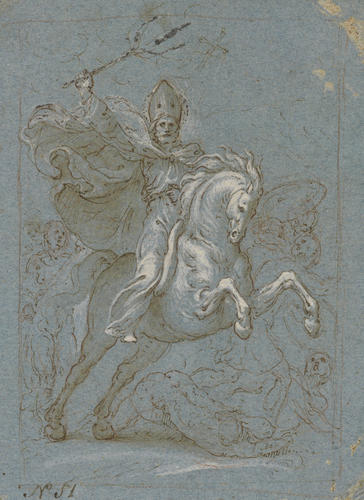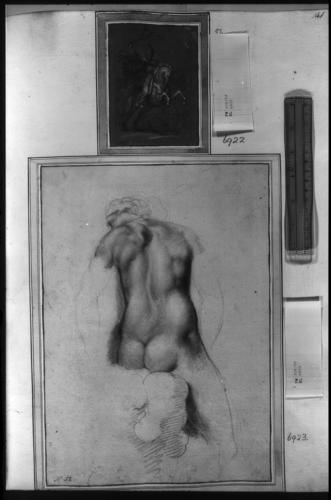St Ambrose expelling the Arian Heretics c.1591
Pen and ink and wash, with white heightening on blue paper | 12.4 x 9.0 cm (sheet of paper) | RCIN 906922
-
A drawing of St Ambrose expelling the Arian heretics.
On 25 January 1590 Ambrogio Figino received a commission for a painting of St Ambrose, patron saint of Milan, showing him driving the Arian heretics out of Milan – a popular local subject matter. As Bishop of Milan he played an important role in crushing Arianism, a doctrine concerning the relationship of God the Father to Christ – regarded heresy in opposition of the orthodox teaching of the Trinity.
The commission was given to him by Carlo Brivio on behalf of the Committee of the Twelve, the executive body of the Milanese magistrate. The painting was intended to form part of an altarpiece for the chapel of the Palazzo della Città, the Broletto Nuovo, in Milan. Figino completed the work on 13 June 1591. He was offered 200 gold ducats in payment for the painting, but he was not pleased by this figure which he considered too low. In order to adjust the matter, a member of the Commission inspected the picture on the day of its completion and described it as 'very beautiful'. Apparently, Figino was offered an acceptable sum on his commissioner's recommendation, since, by 6 July the painting seems to have been already in the chapel.
This drawing shows the composition at a late stage of the preparation for the painting: St Ambrose's horse leaps dynamically from the left to the right. St Ambrose himself, dressed in full bishop regalia, looks directly at the beholder stretching his right arm towards the sky, holding a three-knotted scourge, a symbol of the Trinity, while his cloak flies dramatically behind him. The folds of Ambrose's robe as well as the horse's musculature are heightened in white. These highlights are translated into dramatic lighting of St Ambrose and his steed found in the final painting. In contrast to the more developed structures of the fabric and the horse's coat, the surrounding armed figures are simply outlined in ink. One man has fallen under the horse's hooves; another seeks protection under his shield. The sketch is framed by a rectangular outline indicating that Figino definitively used it in preparation for his painting and that he was testing the composition within this rectangular frame.
Initially, Figino approached the composition quite traditionally: the earliest sketches show the horse charging from left to right seen from the side (inv.nos. 1511r, 1512 Accademia, Venice) or showing the horse leaping from the bottom right corner to the left (inv.no. 369r Accademia, Venice). These earlier sketches were probably inspired by Leonardo da Vinci's compositions for equestrian monuments (RCIN 912360). In particular, the fallen figure underneath the horse, the animal's arching neck and its flying tail seem to testify this influence. During the course of his work on this composition , however, Figino gradually distanced himself from Leonardo and by the time the horse appeared in the final composition, nearly all of the Leonardesque elements had disappeared. The horse's head was turned to turn to the beholder and the body follows and swings out of the diagonal arrangement of the composition.
A drawing in Venice seems to be a direct predecessor to this drawing – both are already very close to the final composition of the finished painting (inv.no. 367). In preparation for this particular painting, Figino made dozens of drawings, being particularly concerned with the movement and position of the horse and rider, see inv.nos. 1512, 1511r, 371, 369, 368r, 374, 367, 373, 366, 365, 370, 372 and 364 at the Accademia in Venice.
Inscribed in pen at lower left: No 51
Provenance
Bequeathed by the artist to Ercole Bianchi in 1608; in the collection of Consul Joseph Smith by 1755; purchased by George III in 1762. Recorded in 'Inventory A', p. 117: '110 Mostly sketches after the Old Masters Raphael, Michel Angelo &c.a.'
-
Creator(s)
-
Medium and techniques
Pen and ink and wash, with white heightening on blue paper
Measurements
12.4 x 9.0 cm (sheet of paper)
Object type(s)









